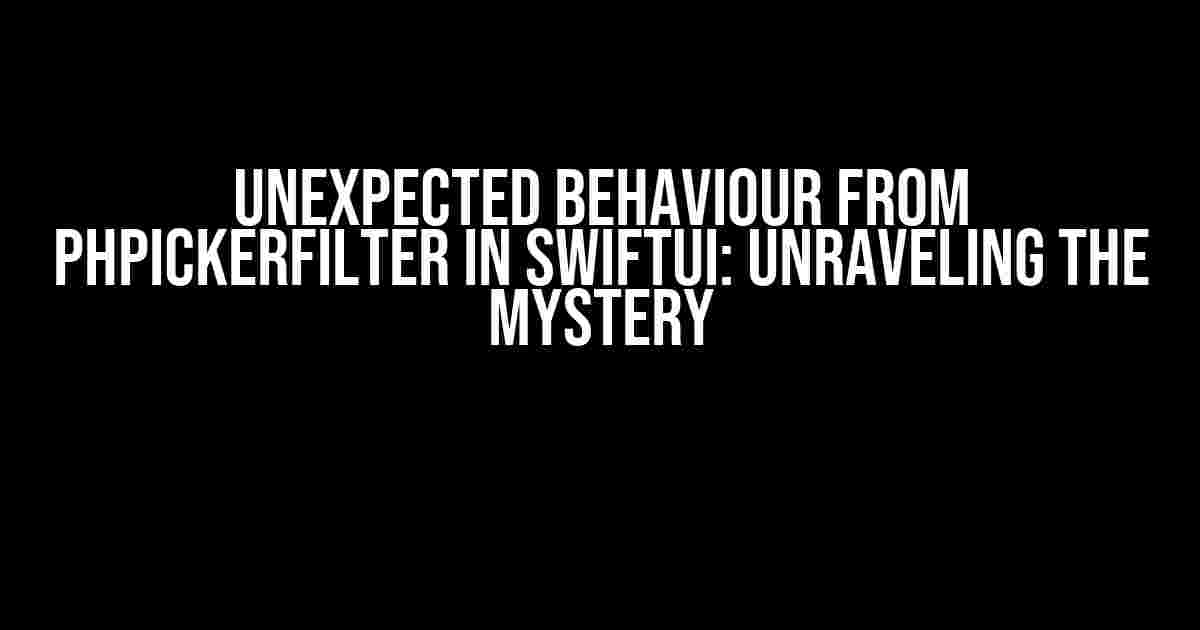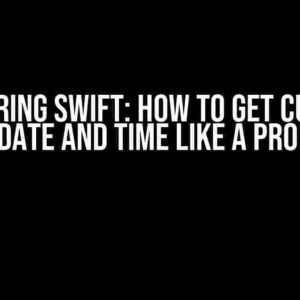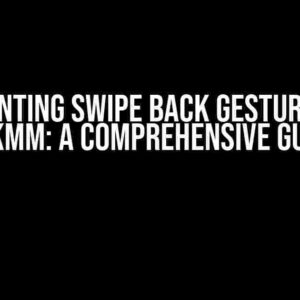Are you a SwiftUI developer who’s been left scratching your head over the unexpected behavior of PHPickerFilter? You’re not alone! Many developers have fallen victim to this enigmatic issue, but fear not, dear reader, for we’re about to embark on a journey to unravel the mystery behind this confounding problem.
What is PHPickerFilter?
Before we dive into the unexpected behavior, let’s take a step back and understand what PHPickerFilter is. PHPickerFilter is a powerful tool in SwiftUI that enables you to filter items in a picker based on a specific condition. It’s a game-changer for building intuitive and user-friendly interfaces.
The Problem: Unexpected Behaviour
So, what’s the problem? You’ve implemented PHPickerFilter in your SwiftUI app, and it’s working like a charm… or so you thought. Suddenly, you notice that the filter is behaving erratically, displaying items that shouldn’t be there or hiding items that should be visible. You’ve tried tweaking the code, but the issue persists.
The root cause of this unexpected behavior lies in the way SwiftUI handles the picker’s data source. When you apply a filter to the picker, SwiftUI creates a new data source that reflects the filtered results. However, if you’re not careful, this can lead to a mismatch between the original data source and the filtered one, resulting in unexpected behavior.
Symptoms of the Problem
Before we delve into the solutions, let’s identify the common symptoms of this issue:
- Items are displayed in the picker that shouldn’t be there
- Items are missing from the picker that should be visible
- The picker’s selection is not updating correctly
- The filter is not being applied consistently
Solution 1: Binding the Filter to the Data Source
The first solution is to bind the filter to the data source using the `@State` property wrapper. This ensures that the filter is updated whenever the data source changes.
@State private var dataSource: [String] = ["Item 1", "Item 2", "Item 3"]
@State private var filter: String = ""
var filteredDataSource: [String] {
return dataSource.filter { $0.contains(filter) }
}
var body: some View {
Picker("Select an item", selection: $selection) {
ForEach(filteredDataSource, id: \.self) {
Text($0)
}
}
}
In this example, we’ve bound the `filter` state variable to the `dataSource` using the `@State` property wrapper. We’ve also created a computed property `filteredDataSource` that returns the filtered results based on the `filter` variable.
Solution 2: Using a Custom Filter Function
If binding the filter to the data source doesn’t solve the issue, you can create a custom filter function that takes into account the original data source and the filter criteria.
func filterItems(_ items: [String], with filter: String) -> [String] {
return items.filter { $0.contains(filter) }
}
var body: some View {
Picker("Select an item", selection: $selection) {
ForEach(filterItems(dataSource, with: filter), id: \.self) {
Text($0)
}
}
}
In this example, we’ve created a custom filter function `filterItems` that takes the original data source `dataSource` and the filter criteria `filter` as input. The function returns the filtered results, which are then used to populate the picker.
Solution 3: Resetting the Filter on Data Source Changes
Sometimes, the unexpected behavior occurs when the data source changes, but the filter is not updated accordingly. To address this, you can reset the filter whenever the data source changes.
@State private var dataSource: [String] = ["Item 1", "Item 2", "Item 3"]
@State private var filter: String = ""
var body: some View {
Picker("Select an item", selection: $selection) {
ForEach(dataSource.filter { $0.contains(filter) }, id: \.self) {
Text($0)
}
}
.onChange(of: dataSource) { _ in
filter = ""
}
}
In this example, we’ve used the `onChange` modifier to reset the filter whenever the data source changes. This ensures that the filter is updated correctly whenever the data source is modified.
Conclusion
Unexpected behavior from PHPickerFilter in SwiftUI can be frustrating, but it’s not an insurmountable problem. By binding the filter to the data source, using a custom filter function, or resetting the filter on data source changes, you can overcome this issue and create a seamless user experience.
Remember, SwiftUI is a powerful tool, but it requires careful attention to detail and a deep understanding of its inner workings. By following the solutions outlined in this article, you’ll be well on your way to taming the beast that is PHPickerFilter.
| Solution | Description |
|---|---|
| Binding the Filter to the Data Source | Bind the filter to the data source using the `@State` property wrapper to ensure the filter is updated whenever the data source changes. |
| Using a Custom Filter Function | Create a custom filter function that takes into account the original data source and the filter criteria to ensure correct filtering. |
| Resetting the Filter on Data Source Changes | Reset the filter whenever the data source changes to ensure the filter is updated correctly. |
By following these solutions and understanding the underlying causes of the unexpected behavior, you’ll be able to harness the full power of PHPickerFilter and create stunning SwiftUI apps that delight your users.
Frequently Asked Question
Are you tired of dealing with the unexpected behavior of PHPickerFilter in SwiftUI? Worry no more! Here are some frequently asked questions and answers to help you troubleshoot and overcome those pesky issues.
Why does PHPickerFilter not filter images correctly?
This is because PHPickerFilter uses a different thread to filter images, which can cause unexpected behavior. Try wrapping your filter code in a DispatchQueue.main.async block to ensure it’s executed on the main thread.
How do I customize the filter options in PHPickerFilter?
You can customize the filter options by creating a custom PHPickerFilter instance and setting its filterTypes property. For example, you can set it to [.images, .videos] to only show images and videos.
Why does PHPickerFilter not work with certain media types?
PHPickerFilter has limitations when it comes to certain media types, such as Live Photos or RAW images. Try using a third-party library or framework that provides more advanced media filtering capabilities.
How do I handle errors when using PHPickerFilter?
To handle errors, use the error property of the PHPickerFilter instance. You can also implement the pickerdidFail error delegate method to catch and handle any errors that occur during the filtering process.
Can I use PHPickerFilter with other SwiftUI views?
Yes, you can use PHPickerFilter with other SwiftUI views, such as lists, grids, or even custom views. Just make sure to wrap the PHPickerFilter instance in a UI representation, such as a List or Grid, to display the filtered media items.



